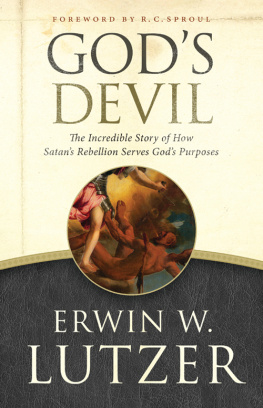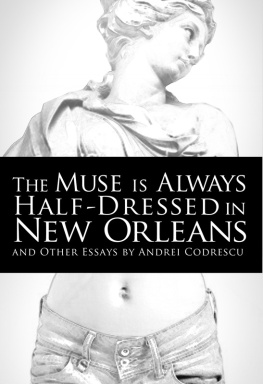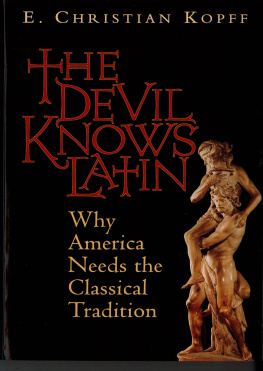MEMOIRS
Ay, Cuba! A Socio-Erotic Journey
Road Scholar
The Hole in the Flag: An Exiles Story of Return and Revolution
In Americas Shoes
The Life and Times of an Involuntary Genius
ESSAYS
Hail Babylon!
The Dog with the Chip in his Neck
Zombification
The Muse is Always Half-Dressed in New Orleans
The Disappearance of the Outside
Raised by Puppets Only to be Killed by Research
A Craving for Swan
POETRY
Alien Candor
Belligerence
Comrade Past and Mister Present
Selected Poems: 19701980
Diapers on the Snow
Necrocorrida
For the Love of a Coat
The Lady Painter
The Marriage of Insult and Injury
A Mote Suite for Jan and Anselm
Grammar and Money
A Serious Morning
Secret Training the, here, what, where
The History of the Growth of Heaven
License to Carry a Gun
FICTION
A Bar in Brooklyn
Messiah
The Blood Countess
Monsieur Teste in America and Other Instances of Realism
The Repentance of Lorraine
Why I Cant Talk on the Telephone
T he Devil never sleeps because hes got too much to do and the things hes already done keep him awake. So the Devil is no different from your average American with too much to do and too much to think about. If there is a difference between the Devil and the average Joe, it is only that the Devil feels no guilt. On the contrary, what keeps him awake at night is the pleasure of remembering, living his deeds all over again. The Devil uses insomnia to live twice, while the average Joe just breaks into a cold sweat.
People once believed seriously in the Devil, so when bad things happened they knew who was responsible for them. Many bad things happened back then, so many that a whole class of church people existed whose only job was to keep track of all the bad things and their degree of badness. Not all things were equally bad. Some bad things that happened to one personally, such as disease and death, were the work of God because they were part of the pattern of common life. Bigger bad things, such as famines, plague, or earthquakes, could have been Gods or the Devils, depending on how wicked or God-fearing people were. If people were God-fearing and bad things happened to them, then it was Devils work. And twice vice versa. If the bad things that happened to the community were the Devils work, then the Devils agents who had caused these things (the Devil used humanminions to do his dirty work) had to be found and burned alive. Burning alive the Devils agents was Gods work and it made people happy. The Devil rather enjoyed seeing his minions burn, so nobody was the worse for it, except the people burning. It was a win-win situation for the living.
The Devil started losing friends and influence in the eighteenth century, when people discovered that many bad things had no single author. French philosophers, in particular, took some spirited whacks at both God and the Devil, though most of themVoltaire, for instancefound the Devil a much more personable figure than his counterpart. The Devil shed much of his dreadfulness for the upper classes, mutating into a sympathetic, carnivalesque character, whose job was to suggest titillating possibilities. Sex and food, or lust and gluttony, lost their sinful terror and became delightful pursuits. Casanovas memoir, The Story of My Life , chronicles, with methodical thoroughness and utter lack of regret, his lifelong indulgences. Casanova wrote his memoir in old age, thus reliving his devilish life during long insomniac nights. The Devils best champion was the Marquis de Sade, who methodically reversed the teachings of the Church to produce pornographic parables curiously devoid of prurience. In De Sades methodical work of virtue-demolition, the Devil is revealed as a logician and a grammarian. De Sades works, written mostly in prison, capture the antagonists in balance.
After the eighteenth century, the Devil got more and more ragged around the edges, like a plush toy kicked around too long by rough children. By the end of the nineteenth century he barely had a place to live: most of the world had been discovered, even the scariest forests, and mens souls were being taken apart by psychology. From carnival to operetta to a banal figure of speech, the Devil seemed to be nearly extinct. And then, surprise! Hitler! The sleeping bourgeoisie, safely ensconced in its ideas of reason and progress, gave birth to the Devil. Hitler embodied every repressed aspect of the Devil since the early Middle Ages. All that had been laughed away came back concentrated inside a little man with a tiny mustache who magnetized all the unfocused evil in the world and made the business of hell both serious and modern. Hitler was the classic Devil of the early Church, ignorant, bloody, banal, bureaucratic. He was part gargoyle, part Luther.
In the Christian world, until the Reformation, the Devil was as serious as the political climate. The Church portrayed him as adaptable. He was insidious and ready to take on as much credibility as was required by the Pope. This combination of adaptability and insatiability pointed to two crucialmodels for the Devil: women and Jews. In his development, the Devil took on women because they were accessible through lust (weaker vessels) and Jews, because they could spread far and wide the Devils dispatches. In the Middle Ages, the Devil looked physically like a Jew, a pictorial and psychological resemblance that was invented by Lutherans and carried forward all the way into Hitlers gas ovens. This fate might have befallen women as well if they hadnt been needed to propagate the race. As it was, only a number of women (witches and temptresses) were chosen to pay for their connection with the Devil, standing in symbolically for all womankind. The Christian Devil never ceased acting in the subconscious of Western people, even though he was greatly neutralized after the end of the seventeenth century. In the eighteenth century, when people were actually reasonable for a few minutes, he began receding again.
When the Inquisition, which was the preeminent detector of witches and falsely converted Jews, lost its efficacy in Europe, it attempted to set roots in the New World. It failed resolutely. The Spanish Crown sent an inquisitor to New Orleans, but the locals shipped him back on the same conveyance he arrived in. He returned years later, not an inquisitor any longer, and distinguished himself by good works among Native Americans. Still, the Devil did get a berth on the Mayflower and came here with the Puritans. After the bloodletting at Salem, the Puritan ethos went underground, whence it emerges at regular intervals in American political and cultural life. Two recent examples: Kenneth Starrs sexual witch hunt, and the prohibition against smoking in public places. The Devil is distinguished by his seductiveness and by the smoke that issues perpetually from his nostrils. Crusaders for so-called morality always take a stand against the Devil, though they often end up working in his interests.
In the closing days of the second Christian millennium, many people in the great democracy of America have started believing in the Devil again. Born-again Christians in this technologically advanced country have begun an unholy obsession with old Satan while, ironically, in less advanced parts of the world, superstitious Islamic fundamentalists believe that America is herself the Devil. No question about it, the Devil is back. He hatches and blooms in the bafflement wrought in the faithful by excessive technology.











